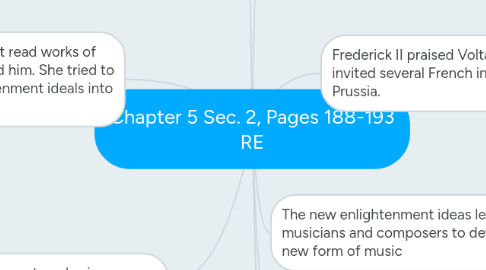Chapter 5 Sec. 2, Pages 188-193 RE
von Race Eckley

1. Joseph II tried to continue the work of Maria Theresa
1.1. Maria Theresa worked to improve peasants way of life
1.2. Joseph supported religious equality for Protestants and Jews and ended Censorship by allowing freedom of press
2. Catherine the Great read works of Voltaire and praised him. She tried to implement Enlightenment ideals into her government
2.1. She abolished torture and established religious tolerance similar to Frederick II
2.2. In the end her main political contribution Expanded the Russian empire
3. New literature, art, and science were regularly discussed in salons
3.1. Salons were informal social gatherings where people shared ideas
4. Louis XIV followed the enlightenment by creating an unorthodox form of architecture called rococo style
4.1. Rococo moved away from religion and was lighter than baroque
5. The enlightenment led to new forms of literature
6. Frederick II praised Voltaire's work and invited several French intellectuals to Prussia.
6.1. Some of his first acts was to reduce torture and allow for freedom of press
6.2. Most of his reforms tried to make the Prussian government more efficient
6.3. Frederick tolerated religious differences. Even so he still demanded a stronger monarchy with more power for himself
7. The new enlightenment ideas led to musicians and composers to develop a new form of music
7.1. John Sebastian wrote religious works for organ and choirs.
7.2. Composer Franz Joseph helped to develop forms for the string quartet and symphony.
8. Church and government felt the need to censor work they deemed inappropriate
8.1. To counter that many writers like Montesquieu and Voltaire disguised their work as fiction


